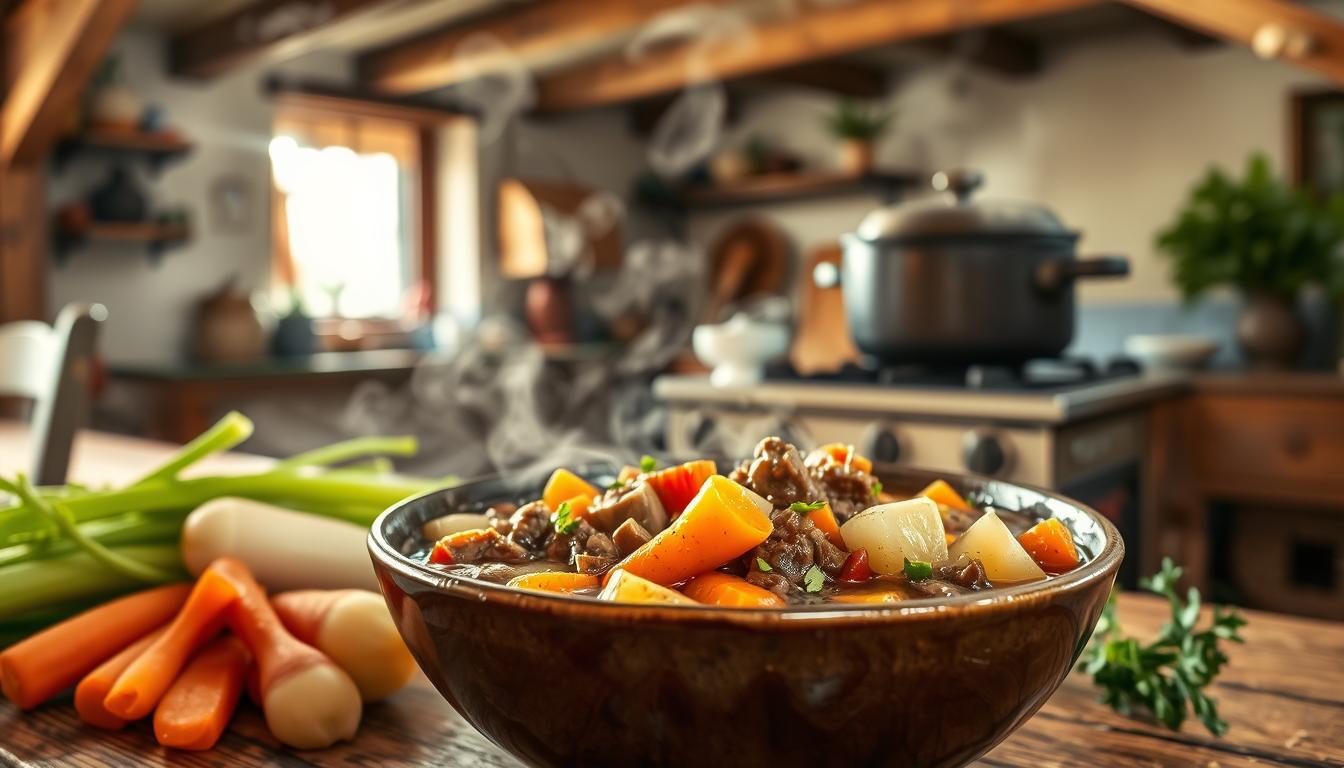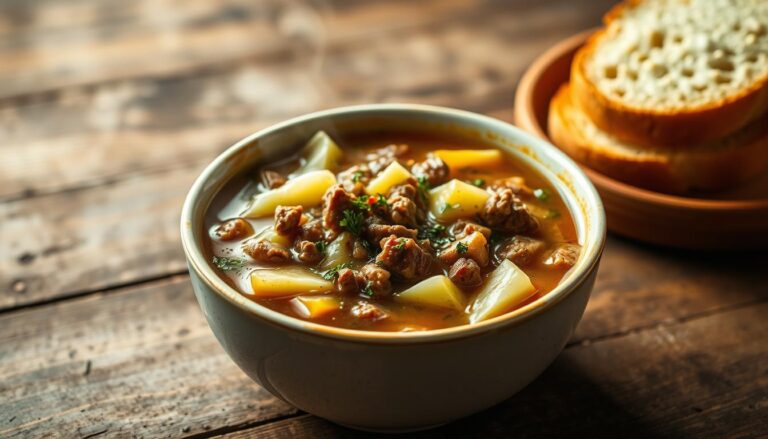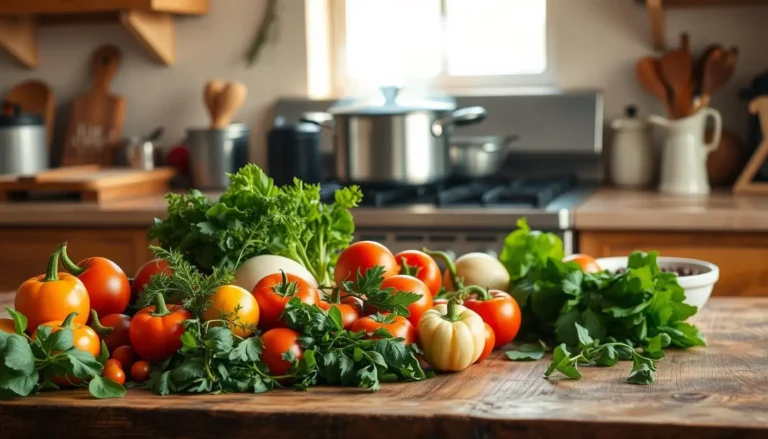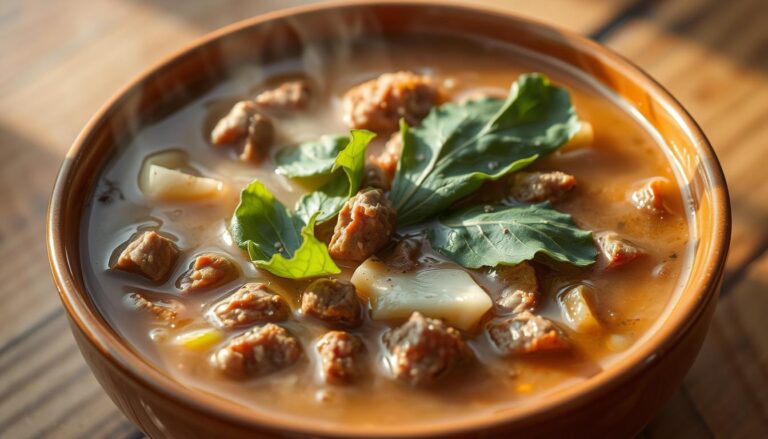How to Make Old-Fashioned Vegetable Beef Soup
When winter winds howl, nothing warms the soul like old-fashioned vegetable beef soup. It’s not just a meal; it’s a treasured memory. It connects generations with its rich, nostalgic flavors.
Growing up, my grandmother’s kitchen always smelled of slow-cooked comfort food. Her vegetable beef soup was more than sustenance; it was a ritual of love. Each ingredient told a story of family tradition. This classic comfort food nourishes both body and spirit.
In this guide, you’ll learn to make the perfect old fashioned vegetable beef soup. We’ll cover selecting premium ingredients and mastering cooking techniques. You’ll see how to turn simple ingredients into an extraordinary culinary experience.
Get ready for a delicious journey that celebrates homemade soup-making. Each spoonful carries the warmth of home and the richness of time-honored cooking traditions.
Table of Contents
Understanding the Classic Appeal of Homemade Beef Soup
Vintage recipes hold a special spot in American kitchens. They connect generations through grandma’s cooking. The classic vegetable beef soup is more than a meal. It’s a tradition that has fed families for years.
Heritage of Traditional Soup Making
Soup making is an art passed down through generations. It turns simple ingredients into a comforting meal. This method lets you make dishes that share family stories and traditions.
- Connects generations through shared recipes
- Preserves cultural cooking techniques
- Transforms basic ingredients into hearty meals
Why This Recipe Stands the Test of Time
The homemade beef soup’s lasting appeal comes from its versatility. It has a high recipe rating of 4.67 out of 5. This dish wins hearts with its rich flavors and health benefits.
Benefits of Making Soup From Scratch
Making soup from scratch has many benefits. You choose the ingredients, boost nutrition, and save money. It can feed up to 8 people. Each serving gives:
- 306 calories
- 15 grams of protein
- Rich in vitamins A and C
By using these vintage recipes, you’re not just cooking. You’re keeping a cherished tradition alive. This tradition brings families together at dinner.
Essential Ingredients for the Perfect Beef Soup
Making a tasty beef stew begins with choosing top-notch ingredients. These ingredients add depth and nutrition to your soup. Root vegetables are key in creating a rich, hearty flavor that warms your heart.
To make the perfect beef soup, you need a special list of ingredients. Here are the must-haves:
- 2 pounds of stew meat or pot roast, cubed into ¾-inch pieces
- 3 large potatoes, diced with skin on for extra nutrients
- 2 cups of fresh vegetables (mix of corn, carrots, green beans, and peas)
- 14 ounces of canned petite diced tomatoes
- 3.5 cups of beef broth
- 1 beef bouillon cube for enhanced flavor
Fresh and root vegetables make your soup balanced and nutritious. Each ingredient adds its own flavor and texture. This turns a simple beef stew into a memorable dish.
Nutritional highlights of this soup include:
- 328 calories per serving
- 31 grams of protein
- 35 grams of carbohydrates
- 7 grams of total fat
- 6 grams of fiber
By picking your ingredients wisely, you’ll make a beef soup that’s more than just a meal. It’s a comforting experience that brings you back to traditional home cooking.
Selecting and Preparing the Best Cut of Beef
Starting a delicious beef stew begins with picking the right meat. The choice you make can turn a simple soup into a memorable meal. It’s a dish that warms the heart and soul.
For tender meat, choose cuts that are best for slow cooking. Chuck roast and pre-cut stew meat are top picks. Each has its own benefits.
Choosing Your Beef Cut
- Chuck Roast:
- Rich marbling for maximum flavor
- Recommended weight: 1.5 lbs
- Cost-effective option
- Pre-cut Stew Meat:
- Convenient and time-saving
- Already trimmed and portioned
- Slightly more expensive
Meat Preparation Techniques
To get the most tender beef stew, follow these steps:
- Trim excess fat from the meat
- Cut into uniform 1-inch cubes
- Pat meat dry before searing
- Season with salt and pepper
Tips for Achieving Tender Meat
Slow cooking is the secret to tender meat. Cooking at low temperatures for a long time breaks down tough tissues. This makes the beef incredibly tender.
“The key to a perfect beef stew is patience and the right cooking technique.” – Professional Chef
When picking your beef, look for cuts with good marbling. The fat melts during slow cooking. This adds rich flavor and keeps the meat juicy and tender.
The Foundation: Creating Rich, Flavorful Broth
Making a savory broth is key to a great beef stew. Your slow cooking turns simple ingredients into a rich base. This base makes the whole dish better.
To make the perfect broth, follow these steps:
- Start with high-quality beef stock as your foundation
- Incorporate natural meat juices during slow cooking
- Use aromatics like onions, garlic, and herbs
- Add depth with Worcestershire sauce
- Season gradually to build complex flavors
Beef stew lovers know slow cooking is essential. It brings out the best flavors. Letting your broth simmer slowly extracts the most taste from each ingredient.
Professional tip: If you’re short on time, boost store-bought broth. Simmer it with roasted beef bones or add red wine. These tricks can make an ordinary broth amazing.
The secret to an unforgettable beef stew is patience and attention to your broth’s flavor development.
Old Fashioned Vegetable Beef Soup Recipe
This old fashioned vegetable beef soup recipe is a hearty one-pot meal. It warms the soul with tender beef, fresh veggies, and rich seasonings. It’s the perfect comfort food for a memorable meal.
Step-by-Step Cooking Instructions
Preparing this classic soup needs careful attention. Start by picking high-quality beef shanks. Then, prepare your ingredients with precision.
- Select 2-3 pounds of beef shanks
- Season meat with black pepper
- Sear beef in a large pot until browned
- Add 8 cups of beef stock
- Incorporate chopped vegetables
Traditional Seasoning Methods
Authentic flavor comes from the right seasonings. Worcestershire sauce and a bay leaf add depth to your soup’s taste.
- 2 teaspoons Worcestershire sauce
- 1 bay leaf
- 1/4 teaspoon ground black pepper
- Optional teaspoon of sugar
Cooking Time and Temperature Guidelines
| Cooking Stage | Time | Purpose |
|---|---|---|
| Initial Simmering | 3 hours | Tenderize beef |
| Vegetable Cooking | 45 minutes | Blend flavors |
| Total Cooking Time | 3 hours 45 minutes | Complete soup preparation |
“A good soup speaks the language of comfort and tradition.”
Your slow cooking method ensures maximum flavor. Serve with crusty bread for a complete meal. It connects you to time-honored culinary traditions.
Fresh and Frozen Vegetable Options
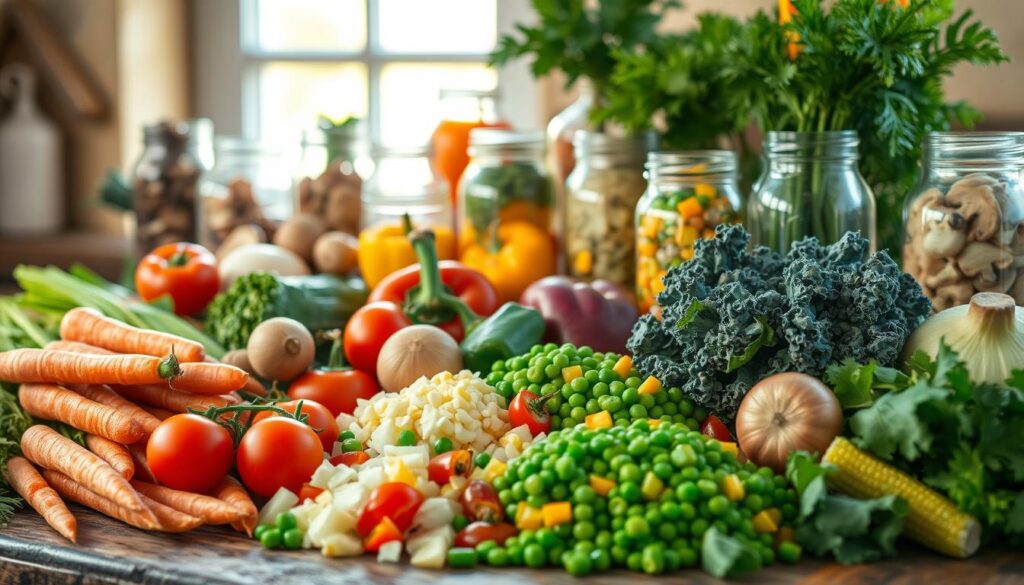
Making a tasty vegetable beef soup lets you try both fresh and frozen veggies. Root veggies are key for a hearty soup that warms you up. The right mix of veggies is crucial for flavor and nutrition.
For fresh veggies, consider these top picks for your soup:
- Carrots – sweet and full of nutrients
- Celery – adds depth and aromatic flavor
- Potatoes – gives a solid texture
- Onions – makes a strong base
Frozen veggies are great for busy days when fresh produce is hard to find. Pro tip: Adding 1 cup of frozen green beans and 1 cup of frozen peas can instantly boost your soup’s veggie content.
Your veggie choice shapes the soup’s character. Fresh root veggies add intense flavor, while frozen options ensure quality all year. Aim for a mix that’s both nutritious and satisfying.
When mixing veggies, keep these tips in mind:
- Add firm veggies first (carrots, onions)
- Put softer veggies in later
- Season each veggie layer for the best flavor
By carefully choosing fresh and frozen veggies, you’ll make a memorable vegetable beef soup. It will please your family and give them important nutrients.
Dutch Oven vs Slow Cooker Methods
Preparing old-fashioned vegetable beef soup is a fun journey with two cooking methods: Dutch oven and slow cooker. Both ways make a tasty one-pot meal that warms your family’s hearts.
Slow cooking offers two great options to make your beef soup a cozy treat. Let’s look at what each method brings to the table.
Dutch Oven: The Flavor Powerhouse
A Dutch oven is a top choice for cooking vegetable beef soup. Its cast-iron body has many benefits:
- Exceptional heat retention
- Even cooking temperature
- Ability to sear meat directly in the pot
- Versatility for stovetop and oven use
Pro tip: Dutch ovens cost from $30 to over $600. Premium brands like Le Creuset come with lifetime warranties.
Slow Cooker: Convenience King
Your slow cooker makes cooking easy. A 3-quart size is perfect for soup, offering:
- Hands-off cooking for 6-8 hours
- Energy-efficient preparation
- Unattended cooking capability
- Consistent low-temperature cooking
Some slow cookers, like the Breville model, have a searing function for better flavor.
Timing and Technique Considerations
Your choice of cooking method affects the soup’s taste. Dutch ovens need gentle stirring every hour. Slow cookers require little effort. Dutch ovens often have richer flavors because of better heat.
Whether you pick Dutch oven or slow cooker, your vegetable beef soup will be a comforting dish for your family.
Secret Tips for Enhanced Flavor
Turning vintage recipes into comfort food magic needs some special tricks. Making a savory broth that wows is more than just a recipe. Here are expert tips to make your vegetable beef soup truly stand out.
Professional chefs know that layering flavors is key to a memorable soup. Try these tips to add depth and complexity to your soup:
- Add a splash of red wine to intensify the meat’s richness
- Use Worcestershire sauce for unexpected umami notes
- Incorporate fresh herbs like thyme or bay leaves
- Experiment with beef bouillon for concentrated flavor
Mastering flavor balance is an art in traditional cooking. Your soup’s taste can be greatly enhanced by knowing how ingredients work together.
| Flavor Enhancer | Impact on Soup | Recommended Quantity |
|---|---|---|
| Red Wine | Deepens meat flavor | 2-3 tablespoons |
| Worcestershire Sauce | Adds umami complexity | 1-2 teaspoons |
| Fresh Thyme | Provides herbal undertones | 1-2 sprigs |
| Bay Leaves | Introduces subtle earthiness | 1-2 leaves |
Seasoning is a personal journey. Trust your taste and adjust ingredients as needed. The aim is to make a dish that warms your soul and shows off your cooking skills.
Storage and Reheating Guidelines
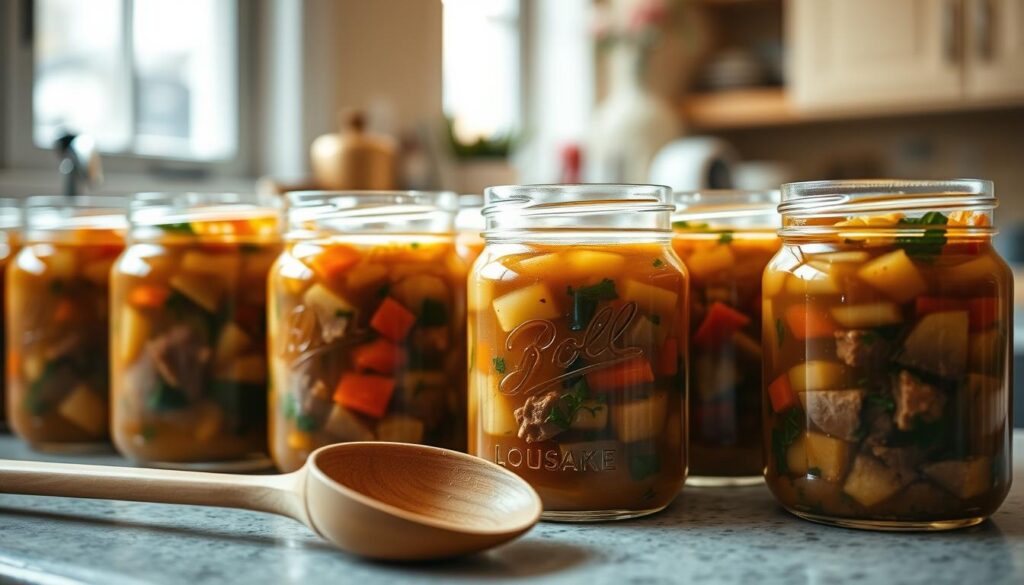
Turning your hearty soup into a convenient meal is easy with the right storage tips. Your vegetable beef soup can stay fresh and delicious for a long time. Just follow the right preservation steps.
First, you can store it in the fridge. After cooking, put the soup in an airtight container for 3 to 4 days. Cool it down to room temperature within 2 hours to stop bacteria from growing.
Freezing Your Soup
Freezing is a great way to keep your soup fresh for longer. Here’s what you need to do:
- Use freezer-safe containers
- Leave 1 inch of space at the top for expansion
- Store for up to 3 months
- Label containers with the date
Reheating Tips
When you reheat your soup, safety and taste are key. Follow these tips:
- Thaw frozen soup in the fridge overnight
- Reheat to an internal temperature of 165°F (74°C)
- Stir occasionally to ensure even heating
- Avoid reheating multiple times to prevent potential foodborne illness
Pro tip: Adding a splash of broth during reheating can help restore the soup’s original moisture and prevent drying out.
Serving Suggestions and Pairings
Make your hearty soup a full meal with the right sides and garnishes. These touches can turn a simple dish into a special meal.
Traditional Side Dishes
Pair your vegetable beef soup with classic dishes to boost its flavors:
- Crusty artisan bread for dipping
- Warm cornbread with a pat of butter
- Simple green salad with light vinaigrette
- Homemade buttermilk biscuits
Bread and Garnish Options
Add a special touch to your soup with these delightful extras:
- Fresh chopped parsley for brightness
- Dollop of sour cream for creaminess
- Grated sharp cheddar cheese
- Cracked black pepper
“A great soup is more than just a meal – it’s a warm embrace on a plate.”
Your vintage recipes are worth the extra effort. The right sides and garnishes can make a simple soup into a memorable meal. It’s a celebration of traditional cooking.
Common Troubleshooting Tips
Making the perfect one-pot meal needs skill. Even seasoned cooks face issues with savory broth-based soups. Knowing common problems can turn cooking mistakes into tasty dishes.
Here are some tips for your hearty soup:
- Tough Meat Solution: If beef is still tough, cook it longer. Let it simmer for at least 1 hour to soften tough cuts like beef chuck.
- Broth Consistency: To fix the broth, add more stock or simmer uncovered to reduce it.
- Vegetable Texture: To keep veggies firm, add carrots and potatoes in the last 20 minutes.
Timing is key for a better soup. Here are important cooking times:
- Brown meat twice for better flavor.
- Simmer beef for about 1 hour.
- Cook veggies for 30-45 minutes more.
- Add fresh herbs like thyme in the last 30 minutes.
Creating a great one-pot meal takes patience and focus. Your savory broth will get richer and more complex with careful cooking. It tastes even better when reheated.
Conclusion
The old-fashioned vegetable beef soup recipe is more than a meal. It’s a journey through family history and comfort food traditions. Your kitchen becomes a bridge connecting generations. It turns simple ingredients like 2 lbs of pot roast, russet potatoes, and frozen vegetables into a heartwarming dish.
When you make this classic soup, you’re not just cooking. You’re recreating a piece of grandma’s cooking that has sustained families for generations. The rich blend of beef broth, tender meat, and colorful vegetables offers a nutritious meal. Each spoonful carries the essence of home-cooked comfort, making it far more than just a typical soup recipe.
This versatile dish fits your kitchen style—whether you prefer a slow cooker method or traditional Dutch oven cooking. With multiple serving options and the ability to store leftovers for up to 3 months, your vegetable beef soup becomes a practical and delicious solution. It’s perfect for busy weeknight dinners or comforting weekend meals. Embrace this timeless recipe and create your own cherished food memories.
Your journey with this old-fashioned vegetable beef soup recipe is an invitation to explore, experiment, and enjoy a truly classic American comfort food. It continues to bring families together around the dinner table.

